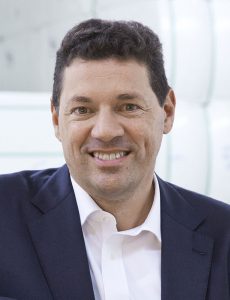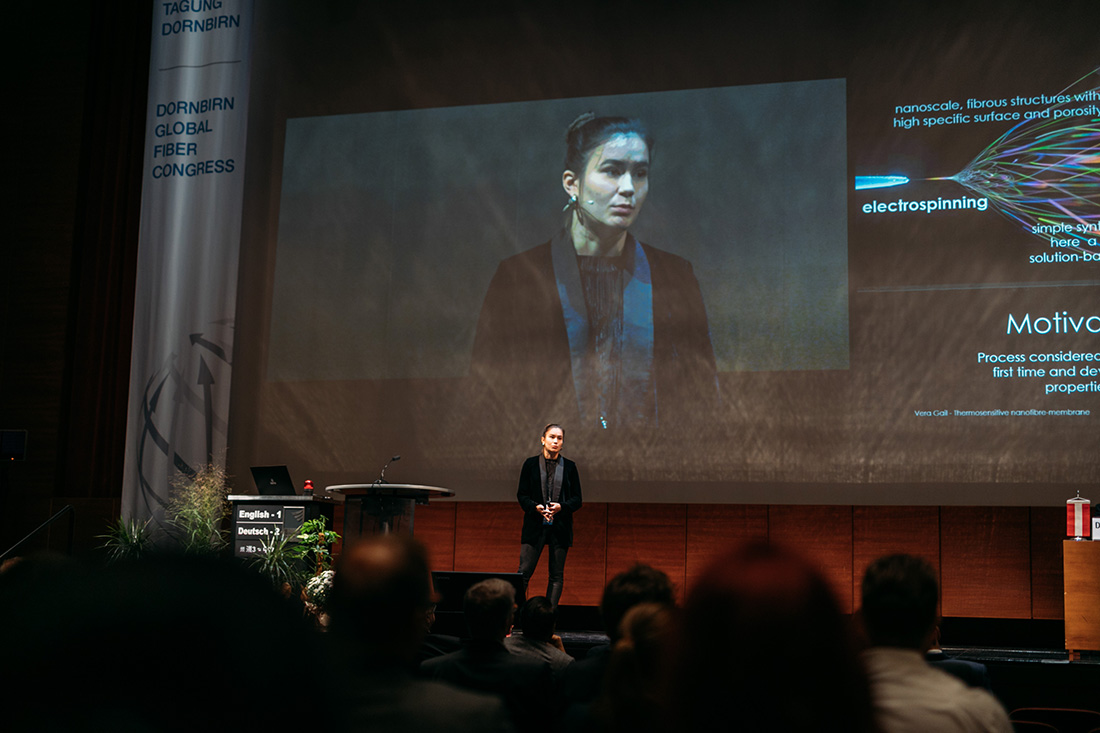With the COVID-19 pandemic continuing to hamper the fiber community with restrictions on travel and public gatherings, the 59th Dornbirn Global Fiber Congress was, for the first time, held virtually.

Opening the congress, Austrian Minister for Climate Action, Environment, Energy, Mobility, Innovation and Technology Leonore Gewessler stressed the importance of the circular economy.
She noted that Austria aims to be climate neutral by 2040, but said new ideas and major investments are needed to ensure the reshaping of industrial production in Europe is successful.
“All our work and all our innovations have to be under the umbrella of the Sustainable Development Goals launched by the United Nations in 2015,” she said, adding that the shift from a linear economy to a circular economy will require a big change in the long-term investment strategy for industry.
On a global scale, the textile sector is one of the most polluting industries, especially when it comes to water pollution, Gewessler noted. “But through dedicated research and development, improvements are possible – the usage of raw materials, energy, water, labor, etc., per unit can be reduced significantly.”
Consumption growth
Many innovations have been presented at, and initiated by, the Dornbirn Global Fiber Conference. However, such positive developments have been outweighed by the growing consumption of fibers and textiles, not only due to population growth, but mainly because of growth in per capita consumption over the past decade, said Gewessler.
Moreover, with more than 100 million tonnes of fibers produced every year for textiles and nonwovens, more than 70 million tonnes end up in landfill or are incinerated, with just a small fraction recycled.
“This is a frightening development and not sustainable, either in terms of resource management or the energy transitions,” said Gewessler, who also touched on the impact of microplastics through laundering of synthetic fibers.
The circular economy, as highlighted in the European Green Deal, needs huge innovation efforts to reshape industry, she said. “The textile value chain, from fiber to final product, is still established in Europe to a major extent. But beyond the textile industry we need to involve production, design, packaging, waste management, logistics, retailers – and consumers.”
Magnus Brunner, state secretary of the Austrian Ministry of Climate Protection, Environment, Mobility, Innovation and Technology, agreed that the recycling and reuse of textiles is a major challenge. “Economy and ecology need to be complementary and will need smart solutions,” he told delegates.
Out of time

Robert van de Kerkhof, chief commercial officer of Lenzing, called for more responsible behavior, arguing that the fiber industry is running out of time and that any changes will take years to come into effect: “We have to act now, although now is too late; it is already five past 12!”
He revealed that the Austria-based cellulosic fiber producer has joined the newly formed Renewable Carbon Initiative as a founding partner, together with 10 other leading companies from six countries, under the leadership of Germany’s Nova-Institute. The aim of this initiative is to support and speed up the transition from fossil carbon to renewable carbon for all organic chemicals and materials.
Volume growth has historically been the textile industry’s driver, “but maybe we need to think about value growth,” he added. “We need to learn from nature and to keep carbon in the loop, and not just keep using fossil-based resources.”
Van de Kerkhof, who is the newly elected president of CIRFS, the European man-made fibers association, also stressed the need for strategic partnerships to improve the textile value chain, which would include investors, machine builders and chemical suppliers, governments, non-governmental organizations and industry leaders.
Fast fashion the culprit
Rajen Udeshi, president, polyester chain at India-based Reliance Industries, reminded delegates that in industry, one in six people work in fashion-related jobs, with per capita fiber consumption doubling over the past four decades.
Meanwhile, the continuing rise of fast fashion has meant that each garment is now worn for less time than ever before, leading to a shorter apparel lifecycle and lower clothing utilization, even in markets such as China.
The lack of recycling has resulted in a huge waste problem, not to mention a huge waste of resources, Udeshi said. Other speakers noted that the price of clothing is far too cheap, with garments no longer being made to last.
Recycling solutions needed

Photo fourtesy of Cecimo
Ruben Dekker, a policy officer on circular economy in the European Commission’s Directorate-General for Environment, discussed the March 2020 launch of the Commission’s Circular Economy Action Plan for a “cleaner and more competitive Europe.”
“The coronavirus pandemic that followed almost immediately is not an excuse to step back, but rather to move forward on climate and the environment,” he said. “There will be mandatory separate collections for clothing in the EU by 2025 and that will create a huge resource. The industry needs to view waste material as an opportunity, not as a problem.”
Dekker noted that in Europe one full truckload of textiles goes to landfill or is incinerated every second, and that only 1% of all textile fibers are recycled. “We urgently need solutions,” he said.
PPE challenges
Recycling/reuse and the circular economy were the dominant themes of this year’s pared-down fiber congress. A far more focused program, although highly Eurocentric, featured 24 presentations and four panel discussions, with sessions including personal protective equipment (PPE) and new recycling technologies.
Unusually amongst the current glut of online conferences, the “webinar week” was free to delegates, with around 400 people participating, according to event organizer, the Austrian Fibers Institute.
It was generally agreed that the recycling of PPE, which is still largely sourced from the Far East, will be difficult owing to the need for hospital collection systems, including transport and handling, and waste treatment facilities, as well as the risk of infection from contaminated products.
Stephan Trubrich, managing director of Hygiene Austria, a joint venture between Lenzing and Palmers Textil, explained that the industry in general, and Lenzing in particular, is currently looking at producing a biodegradable facemask; research is also being undertaken into the use of bio-based microfibers.
Moreover, with more than 100 million tonnes of fibers produced every year for textiles and nonwovens, more than 70 million tonnes end up in landfill or are incinerated, with just a small fraction recycled.
Meanwhile, Pierre Wiertz, general manager of EDANA, the European association for the nonwovens and related industries, questioned whether the EU really wants to deliver a more self-sufficient PPE industry.
Chemical recycling potential
In discussions on textile recycling in general, the limitations of mechanical recycling methods were highlighted, particularly with regard to mixed materials.
However, chemical recycling is the real game-changer, as it appears to offer the best long-term solution, although this will take at least another five years, and most probably more, for sustainable – and affordable – textile-to-textile recycling processes to be developed. Municipal collection, sorting and cleaning systems will also need to be improved.
Mixed-material textiles (blends) in particular pose a major problem – the more components in a product, the more difficult it is to recycle, even by chemical methods. This raises the question of designing for products’ end of life. Some global brands are beginning to address this issue, but the whole supply chain will need to work together, while avoiding the danger of over-engineered products.
“The fiber industry has to learn from the packaging industry about easy-to-recycle materials,” commented Thomas Pichler, chief technology officer of NGR Plastic Recycling Technologies.
Paul Schlack/Wilhelm Albrecht prize
Also during the congress, the Paul Schlack/Wilhelm Albrecht prize 2020 was awarded to Jasmin Jung, Ph.D., project manager at the Hohenstein Institute for Textile Innovation, for her work on image analysis to detect fibers in wastewater from textile washing processes. The award was presented by CIRFS director general Frédéric van Houte.
The 60th Dornbirn Global Fiber Congress is scheduled to take place on September 15–17, 2021 in Dornbirn, Austria.
The postponed 1st Dornbirn-GFC Asia Congress is now planned to take place in Seoul, South Korea, on March 2–3, 2021 (to be confirmed) in co-operation with KOFOTI and Dyetec.
For more information contact:
Austrian Fibers Institute
Tel: +43 1 319 290941
Fax: +43 1 319 290931
Email: office@dornbirn-gfc.com
Website: www.dornbirn-gfc.com or www.dornbirngfc-asia.com


